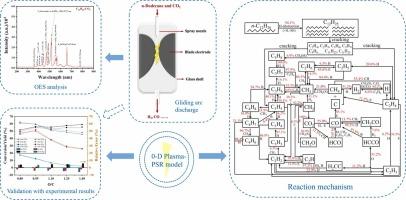Gliding arc plasma dry reforming of n-dodecane for H2 production: A mechanism study combined with experimental methods and kinetic modeling
引用次数: 0
Abstract
Dry reforming technology is promising because it can simultaneously produce syngas (H2 and CO) and efficiently convert the greenhouse gas CO2. This study investigated the dry reforming (DR) of n-dodecane in a gliding arc plasma (GAP) reactor through integrated experimental and kinetic simulation approaches. Key operating parameters—O/C molar ratio, input power, and residence time—were evaluated for their influence on syngas production and reactant conversion. Optical emission spectroscopy (OES) identified active species, with spectral line intensities analyzed across varying O/C ratios. A validated zero-dimensional kinetic model, aligned with experimental data, revealed that H2 generation during C12H26 conversion is predominantly driven by recombination of n-dodecane with H atoms. H₂ production primarily arises from hydrocarbon electron impact reactions (e.g., C₂H₆, C₂H₄) and H atom recombination with species such as C₃H₆, CH₄, and C₃H₈. Detailed reaction pathways and mechanisms in the dry reforming system are elucidated through integrated experimental and kinetic modeling analyses. The n-dodecane conversion follows the following order: X(DR) > X(SR) > X(POR).

滑行电弧等离子体干重整制氢:实验方法与动力学建模相结合的机理研究
干式重整技术可以同时生产合成气(H2和CO)并有效地转化温室气体CO2,因此具有广阔的应用前景。采用实验和动力学模拟相结合的方法研究了正十二烷在滑动电弧等离子体反应器中的干重整过程。考察了关键操作参数o /C摩尔比、输入功率和停留时间对合成气产量和反应物转化率的影响。光学发射光谱(OES)鉴定了活性物种,并分析了不同O/C比率下的光谱线强度。验证的零维动力学模型与实验数据一致,表明C12H26转化过程中H2的生成主要是由正十二烷与H原子的重组驱动的。H₂的产生主要来自碳氢化合物的电子冲击反应(例如,C₂H₆,C₂H₄)和H原子与C₃H₆,CH₄和C₃H₈等品种的复合。通过实验和动力学模型的综合分析,详细阐述了干式重整体系的反应途径和机理。正十二烷的转化顺序为:X(DR) >; X(SR) >; X(POR)。
本文章由计算机程序翻译,如有差异,请以英文原文为准。
求助全文
约1分钟内获得全文
求助全文

 求助内容:
求助内容: 应助结果提醒方式:
应助结果提醒方式:


